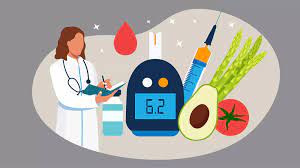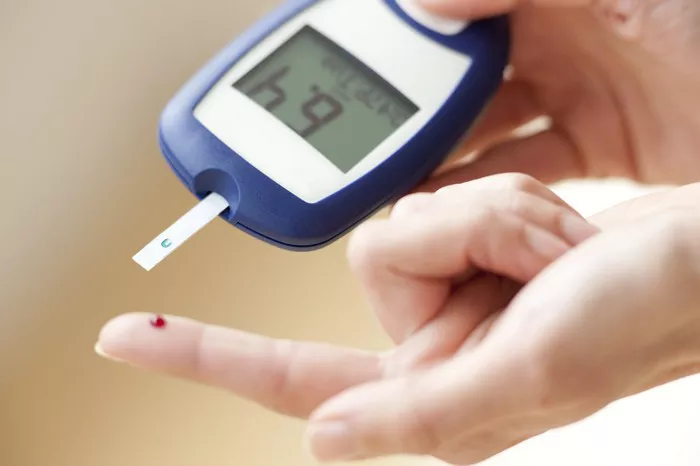Type 1 diabetes is a chronic autoimmune condition that affects how the body regulates blood sugar (glucose). Unlike type 2 diabetes, which often develops over time due to lifestyle factors, type 1 diabetes is typically diagnosed in children, adolescents, or young adults and is not preventable. It results from the immune system attacking and destroying the insulin-producing beta cells in the pancreas. Without insulin, glucose cannot enter the cells and remains in the bloodstream, leading to high blood sugar levels (hyperglycemia).
This article will explore what type 1 diabetes causes in the body, from the immediate effects of high blood sugar to the long-term complications that can arise if the condition is not properly managed. Understanding the impact of type 1 diabetes is crucial for those living with the disease, their families, and healthcare providers working to optimize treatment and improve quality of life.
The Immediate Effects of Type 1 Diabetes
Type 1 diabetes has a direct and immediate impact on the body due to the lack of insulin. Insulin is the hormone responsible for helping glucose enter the cells to be used as energy. Without insulin, several physiological changes occur rapidly.
Hyperglycemia (High Blood Sugar Levels)
The hallmark of type 1 diabetes is hyperglycemia, or high blood sugar levels. Since the body cannot produce insulin, glucose accumulates in the bloodstream. Hyperglycemia can cause a range of immediate symptoms, including:
- Increased thirst (polydipsia)
- Frequent urination (polyuria)
- Blurred vision
- Fatigue and weakness
- Unexplained weight loss
These symptoms are often the first signs of type 1 diabetes and can develop rapidly over a few weeks. If hyperglycemia is not treated, it can lead to more severe complications.
Diabetic Ketoacidosis (DKA)
One of the most serious and potentially life-threatening complications of type 1 diabetes is diabetic ketoacidosis (DKA). DKA occurs when the body, unable to use glucose for energy, begins to break down fat as an alternative fuel source. This process produces ketones, acidic byproducts that accumulate in the blood and can lead to metabolic acidosis.
Symptoms of DKA include:
- Nausea and vomiting
- Abdominal pain
- Deep, rapid breathing (Kussmaul respirations)
- Fruity-smelling breath (due to ketones)
- Confusion or unconsciousness
DKA requires immediate medical attention and is often the initial event leading to a diagnosis of type 1 diabetes in newly diagnosed individuals. It can be fatal if not treated promptly with insulin therapy, fluids, and electrolyte replacement.
Long-Term Effects and Complications of Type 1 Diabetes
Type 1 diabetes affects multiple systems in the body, and without proper management, it can lead to a wide range of long-term complications. These complications are primarily caused by chronic hyperglycemia, which damages blood vessels, nerves, and organs over time. Let’s explore some of the most common long-term effects of type 1 diabetes.
Cardiovascular Disease
Type 1 diabetes significantly increases the risk of cardiovascular disease, including heart attacks, strokes, and peripheral artery disease. Chronic high blood sugar levels can damage the walls of the blood vessels, leading to atherosclerosis (the buildup of fatty deposits in the arteries). This process narrows the arteries, restricting blood flow and increasing the risk of cardiovascular events.
People with type 1 diabetes are also at a higher risk of developing hypertension (high blood pressure) and dyslipidemia (abnormal cholesterol levels), both of which contribute to cardiovascular disease. Managing blood sugar levels, blood pressure, and cholesterol is essential for reducing the risk of heart disease in individuals with type 1 diabetes.
Diabetic Retinopathy
One of the most common complications of type 1 diabetes is diabetic retinopathy, a condition that affects the eyes. High blood sugar levels can damage the small blood vessels in the retina, the light-sensitive tissue at the back of the eye. Over time, this can lead to vision problems, including blurred vision, floaters, and, in severe cases, blindness.
There are two main types of diabetic retinopathy:
- Non-proliferative retinopathy: In the early stages, small blood vessels in the retina may weaken and develop tiny bulges (microaneurysms) that can leak fluid or blood into the retina.
- Proliferative retinopathy: In more advanced stages, the retina may begin to grow new blood vessels (neovascularization) that are weak and prone to bleeding. This can lead to scar tissue formation and retinal detachment, causing severe vision loss.
Regular eye exams are crucial for people with type 1 diabetes to detect retinopathy early and prevent vision loss through timely treatment, which may include laser therapy or injections of medication into the eye.
Diabetic Nephropathy (Kidney Disease)
Diabetic nephropathy is a common complication of type 1 diabetes that affects the kidneys. High blood sugar levels can damage the tiny blood vessels in the kidneys, impairing their ability to filter waste from the blood. This condition progresses slowly over time and can lead to chronic kidney disease (CKD) and, eventually, kidney failure.
Symptoms of diabetic nephropathy may include:
- Swelling in the legs, ankles, feet, or hands (due to fluid retention)
- Fatigue and weakness
- Nausea and vomiting
- Difficulty concentrating
Early detection of kidney disease is essential, as treatment with medications such as ACE inhibitors or angiotensin II receptor blockers (ARBs) can help protect kidney function and slow the progression of the disease.
Diabetic Neuropathy (Nerve Damage)
Diabetic neuropathy is a common complication of type 1 diabetes that affects the nerves, particularly in the extremities (hands and feet). High blood sugar levels can damage the small blood vessels that supply the nerves, leading to nerve dysfunction. There are several types of diabetic neuropathy, including:
Peripheral neuropathy: This is the most common form of diabetic neuropathy and affects the nerves in the feet, legs, and hands. Symptoms include numbness, tingling, burning, and pain.
Autonomic neuropathy: This form of neuropathy affects the nerves that control involuntary functions, such as heart rate, blood pressure, digestion, and bladder control. Symptoms may include digestive problems, dizziness, and difficulty regulating blood pressure.
Focal neuropathy: This type of neuropathy affects specific nerves, causing sudden weakness or pain in a particular area, such as the face, torso, or legs.
Neuropathy can lead to complications such as foot ulcers, infections, and, in severe cases, amputation. Managing blood sugar levels and regular foot care are essential to preventing and treating diabetic neuropathy.
Skin Conditions
People with type 1 diabetes are more prone to developing various skin conditions, many of which are related to poor circulation, nerve damage, and a weakened immune system. Common skin problems include:
Bacterial infections: Staphylococcus bacteria can cause skin infections, such as boils, styes, and cellulitis, which are more common in people with diabetes.
Fungal infections: Candida (yeast) infections, such as athlete’s foot, jock itch, and ringworm, are more prevalent in individuals with diabetes.
Diabetic dermopathy: This condition causes small, round, brown patches on the skin, often on the shins. It’s generally harmless but can be unsightly.
Necrobiosis lipoidica diabeticorum (NLD): NLD causes raised, shiny patches of skin, often on the lower legs, that can develop into open sores.
Good skin hygiene, moisturizing, and prompt treatment of infections can help prevent complications related to skin problems in people with type 1 diabetes.
Gastrointestinal Issues
Type 1 diabetes can cause gastrointestinal issues due to nerve damage affecting the digestive system, a condition known as diabetic gastroparesis. Gastroparesis occurs when the stomach takes too long to empty its contents into the small intestine, leading to symptoms such as:
- Nausea and vomiting
- Bloating and fullness after eating small amounts
- Abdominal pain
- Erratic blood sugar levels due to delayed digestion
Managing gastroparesis often involves dietary changes, medications to stimulate stomach emptying, and, in some cases, surgical interventions.
Mental Health Impact
Living with type 1 diabetes can take a toll on mental health. The constant need to monitor blood sugar levels, administer insulin, and manage diet and exercise can lead to stress, anxiety, and depression. The fear of complications, hypoglycemic episodes, and the burden of managing a chronic condition can affect emotional well-being.
It’s important for individuals with type 1 diabetes to seek mental health support when needed, whether through counseling, support groups, or talking with healthcare providers about the emotional aspects of living with the disease.
Managing and Preventing Complications
The key to managing type 1 diabetes and preventing complications is maintaining tight control of blood sugar levels. This requires a combination of insulin therapy, regular blood glucose monitoring, a balanced diet, physical activity, and regular medical check-ups.
Insulin Therapy
Insulin therapy is the cornerstone of type 1 diabetes management. People with type 1 diabetes need to take insulin to replace the hormone their pancreas no longer produces. Insulin can be administered through multiple daily injections or an insulin pump. The goal is to keep blood sugar levels within a target range to prevent both hyperglycemia and hypoglycemia (low blood sugar).
Blood Glucose Monitoring
Frequent blood glucose monitoring is essential for people with type 1 diabetes to track their blood sugar levels and adjust their insulin doses accordingly. Continuous glucose monitors (CGMs) are increasingly being used to provide real-time blood sugar data and help individuals make more informed decisions about their insulin, diet, and activity.
Diet and Exercise
A balanced diet and regular exercise play a crucial role in managing type 1 diabetes. Carbohydrate counting helps individuals match their insulin doses to the amount of carbohydrates they eat, while regular physical activity can improve insulin sensitivity and overall health.
Regular Medical Check-ups
Regular medical check-ups with a healthcare provider are essential for monitoring the health of individuals with type 1 diabetes. This includes routine screenings for complications such as eye exams, kidney function tests, and foot exams.
See also: What are Early Warning Signs of Type 1 Diabetes
Conclusion
Type 1 diabetes is a complex and lifelong condition that affects multiple systems in the body. From the immediate effects of hyperglycemia and the risk of diabetic ketoacidosis to the long-term complications such as cardiovascular disease, neuropathy, and kidney disease, the impact of type 1 diabetes is far-reaching. However, with proper management and a proactive approach to care, individuals with type 1 diabetes can live healthy and fulfilling lives. Maintaining blood sugar control, monitoring for complications, and seeking support from healthcare providers are key to minimizing the effects of the disease and preventing long-term damage.
Related topics:
What Causes Blood Sugar To Drop In Non Diabetics

























